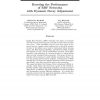Free Online Productivity Tools
i2Speak
i2Symbol
i2OCR
iTex2Img
iWeb2Print
iWeb2Shot
i2Type
iPdf2Split
iPdf2Merge
i2Bopomofo
i2Arabic
i2Style
i2Image
i2PDF
iLatex2Rtf
Sci2ools
NIPS
1994
1994
Boosting the Performance of RBF Networks with Dynamic Decay Adjustment
Radial Basis Function (RBF) Networks, also known as networks of locally{tuned processing units (see 6]) are well known for their ease of use. Most algorithms used to train these types of networks, however, require a xed architecture, in which the number of units in the hidden layer must be determined before training starts. The RCE training algorithm, introduced by Reilly, Cooper and Elbaum (see 8]), and its probabilistic extension, the P{RCE algorithm, take advantage of a growing structure in which hidden units are only introduced when necessary. The nature of these algorithms allows training to reach stability much faster than is the case for gradient{descent based methods. Unfortunately P{RCE networks do not adjust the standard deviation of their prototypes individually, using only one global value for this parameter. This paper introduces the Dynamic Decay Adjustment (DDA) algorithm which utilizes the constructive nature of the P{RCE algorithm together with independent adaptation ...
| Added | 02 Nov 2010 |
| Updated | 02 Nov 2010 |
| Type | Conference |
| Year | 1994 |
| Where | NIPS |
| Authors | Michael R. Berthold, Jay Diamond |
Comments (0)

